BUS708 Statistics & Data Analysis: Airport Service Improvement
VerifiedAdded on 2023/04/21
|9
|1734
|256
Report
AI Summary
This report analyzes airline service data from Australia to provide recommendations for airport service improvements. The analysis uses two datasets: one with general international flight data and another with survey data from students. The report includes numerical summaries, graphical representations, and hypothesis testing to address specific research questions. Key findings include the asymmetric distribution of flight numbers, the average number of monthly international flights, and the relationship between selected airlines and Australian cities. The report concludes with recommendations for Sydney Airport and suggestions for future research, emphasizing the importance of understanding passenger preferences to enhance airport services.
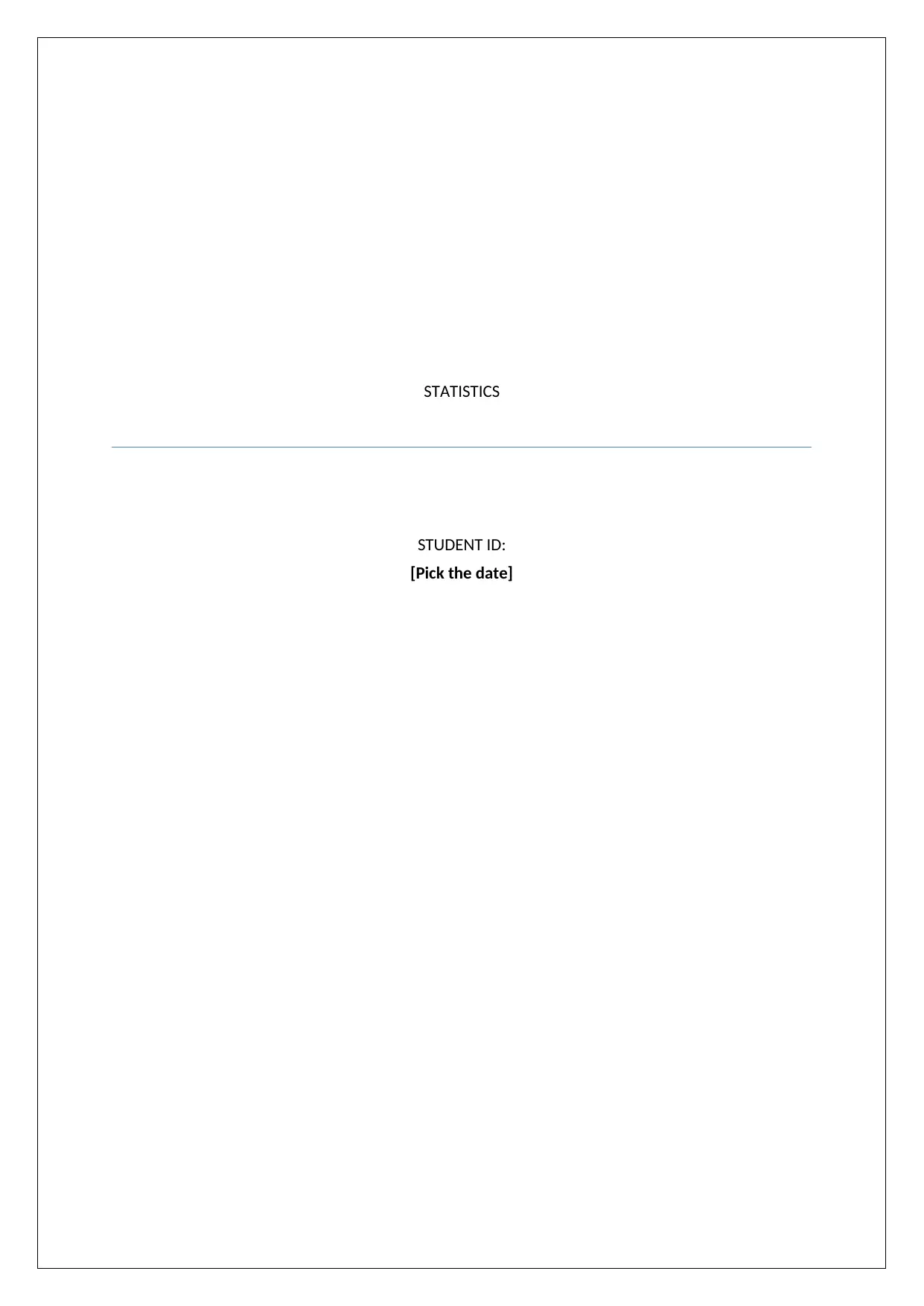
STATISTICS
STUDENT ID:
[Pick the date]
STUDENT ID:
[Pick the date]
Paraphrase This Document
Need a fresh take? Get an instant paraphrase of this document with our AI Paraphraser
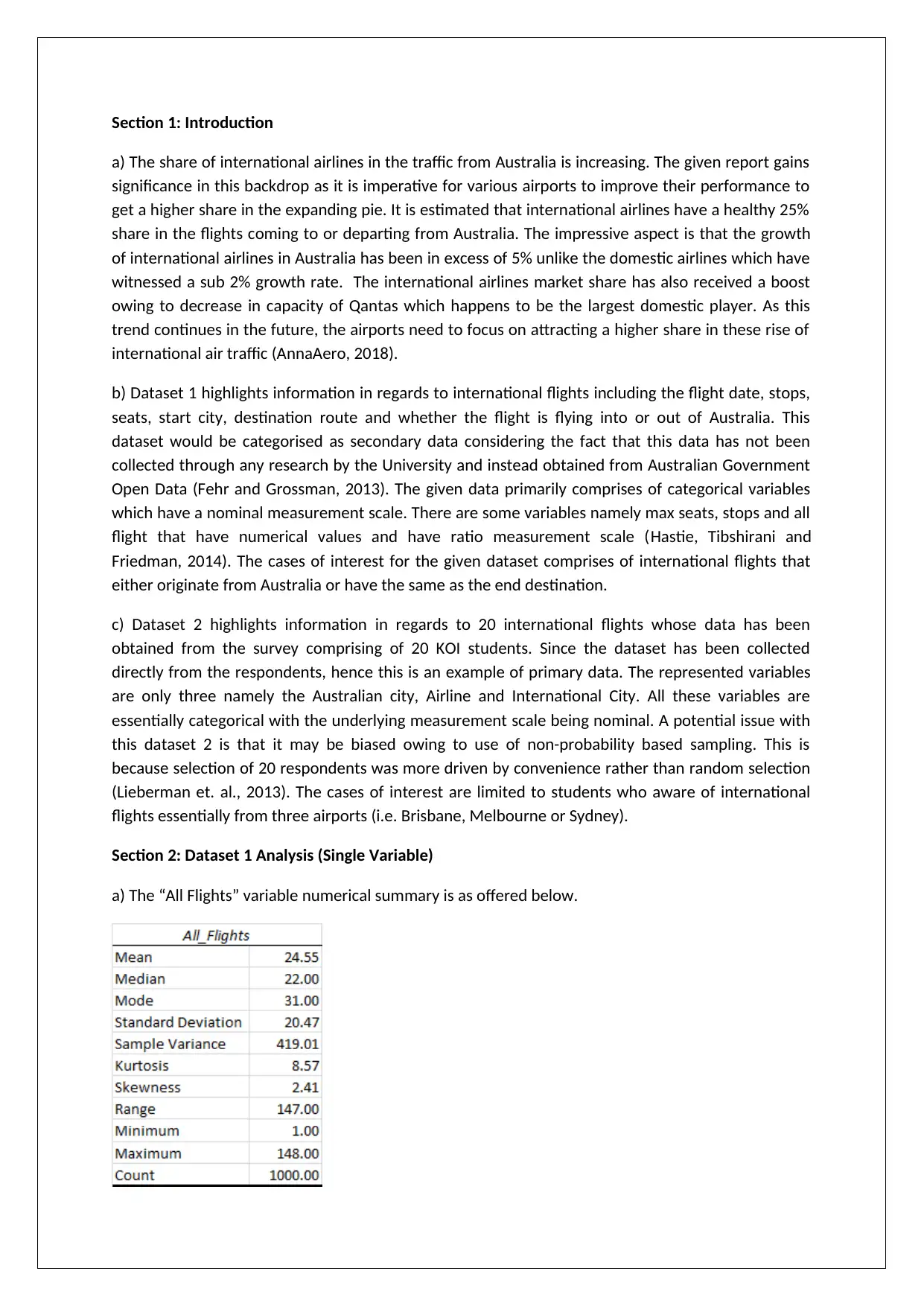
Section 1: Introduction
a) The share of international airlines in the traffic from Australia is increasing. The given report gains
significance in this backdrop as it is imperative for various airports to improve their performance to
get a higher share in the expanding pie. It is estimated that international airlines have a healthy 25%
share in the flights coming to or departing from Australia. The impressive aspect is that the growth
of international airlines in Australia has been in excess of 5% unlike the domestic airlines which have
witnessed a sub 2% growth rate. The international airlines market share has also received a boost
owing to decrease in capacity of Qantas which happens to be the largest domestic player. As this
trend continues in the future, the airports need to focus on attracting a higher share in these rise of
international air traffic (AnnaAero, 2018).
b) Dataset 1 highlights information in regards to international flights including the flight date, stops,
seats, start city, destination route and whether the flight is flying into or out of Australia. This
dataset would be categorised as secondary data considering the fact that this data has not been
collected through any research by the University and instead obtained from Australian Government
Open Data (Fehr and Grossman, 2013). The given data primarily comprises of categorical variables
which have a nominal measurement scale. There are some variables namely max seats, stops and all
flight that have numerical values and have ratio measurement scale (Hastie, Tibshirani and
Friedman, 2014). The cases of interest for the given dataset comprises of international flights that
either originate from Australia or have the same as the end destination.
c) Dataset 2 highlights information in regards to 20 international flights whose data has been
obtained from the survey comprising of 20 KOI students. Since the dataset has been collected
directly from the respondents, hence this is an example of primary data. The represented variables
are only three namely the Australian city, Airline and International City. All these variables are
essentially categorical with the underlying measurement scale being nominal. A potential issue with
this dataset 2 is that it may be biased owing to use of non-probability based sampling. This is
because selection of 20 respondents was more driven by convenience rather than random selection
(Lieberman et. al., 2013). The cases of interest are limited to students who aware of international
flights essentially from three airports (i.e. Brisbane, Melbourne or Sydney).
Section 2: Dataset 1 Analysis (Single Variable)
a) The “All Flights” variable numerical summary is as offered below.
a) The share of international airlines in the traffic from Australia is increasing. The given report gains
significance in this backdrop as it is imperative for various airports to improve their performance to
get a higher share in the expanding pie. It is estimated that international airlines have a healthy 25%
share in the flights coming to or departing from Australia. The impressive aspect is that the growth
of international airlines in Australia has been in excess of 5% unlike the domestic airlines which have
witnessed a sub 2% growth rate. The international airlines market share has also received a boost
owing to decrease in capacity of Qantas which happens to be the largest domestic player. As this
trend continues in the future, the airports need to focus on attracting a higher share in these rise of
international air traffic (AnnaAero, 2018).
b) Dataset 1 highlights information in regards to international flights including the flight date, stops,
seats, start city, destination route and whether the flight is flying into or out of Australia. This
dataset would be categorised as secondary data considering the fact that this data has not been
collected through any research by the University and instead obtained from Australian Government
Open Data (Fehr and Grossman, 2013). The given data primarily comprises of categorical variables
which have a nominal measurement scale. There are some variables namely max seats, stops and all
flight that have numerical values and have ratio measurement scale (Hastie, Tibshirani and
Friedman, 2014). The cases of interest for the given dataset comprises of international flights that
either originate from Australia or have the same as the end destination.
c) Dataset 2 highlights information in regards to 20 international flights whose data has been
obtained from the survey comprising of 20 KOI students. Since the dataset has been collected
directly from the respondents, hence this is an example of primary data. The represented variables
are only three namely the Australian city, Airline and International City. All these variables are
essentially categorical with the underlying measurement scale being nominal. A potential issue with
this dataset 2 is that it may be biased owing to use of non-probability based sampling. This is
because selection of 20 respondents was more driven by convenience rather than random selection
(Lieberman et. al., 2013). The cases of interest are limited to students who aware of international
flights essentially from three airports (i.e. Brisbane, Melbourne or Sydney).
Section 2: Dataset 1 Analysis (Single Variable)
a) The “All Flights” variable numerical summary is as offered below.
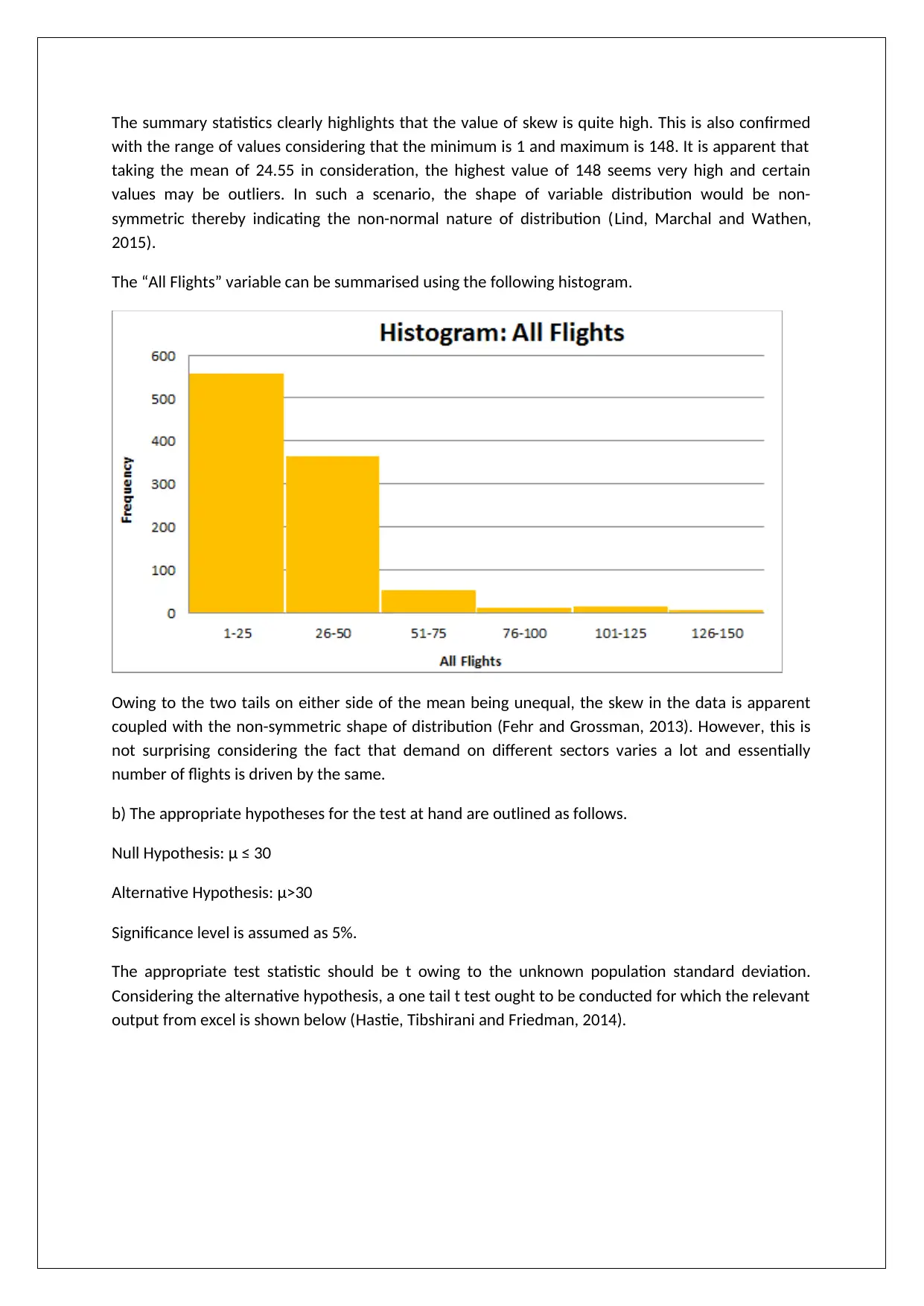
The summary statistics clearly highlights that the value of skew is quite high. This is also confirmed
with the range of values considering that the minimum is 1 and maximum is 148. It is apparent that
taking the mean of 24.55 in consideration, the highest value of 148 seems very high and certain
values may be outliers. In such a scenario, the shape of variable distribution would be non-
symmetric thereby indicating the non-normal nature of distribution (Lind, Marchal and Wathen,
2015).
The “All Flights” variable can be summarised using the following histogram.
Owing to the two tails on either side of the mean being unequal, the skew in the data is apparent
coupled with the non-symmetric shape of distribution (Fehr and Grossman, 2013). However, this is
not surprising considering the fact that demand on different sectors varies a lot and essentially
number of flights is driven by the same.
b) The appropriate hypotheses for the test at hand are outlined as follows.
Null Hypothesis: μ ≤ 30
Alternative Hypothesis: μ>30
Significance level is assumed as 5%.
The appropriate test statistic should be t owing to the unknown population standard deviation.
Considering the alternative hypothesis, a one tail t test ought to be conducted for which the relevant
output from excel is shown below (Hastie, Tibshirani and Friedman, 2014).
with the range of values considering that the minimum is 1 and maximum is 148. It is apparent that
taking the mean of 24.55 in consideration, the highest value of 148 seems very high and certain
values may be outliers. In such a scenario, the shape of variable distribution would be non-
symmetric thereby indicating the non-normal nature of distribution (Lind, Marchal and Wathen,
2015).
The “All Flights” variable can be summarised using the following histogram.
Owing to the two tails on either side of the mean being unequal, the skew in the data is apparent
coupled with the non-symmetric shape of distribution (Fehr and Grossman, 2013). However, this is
not surprising considering the fact that demand on different sectors varies a lot and essentially
number of flights is driven by the same.
b) The appropriate hypotheses for the test at hand are outlined as follows.
Null Hypothesis: μ ≤ 30
Alternative Hypothesis: μ>30
Significance level is assumed as 5%.
The appropriate test statistic should be t owing to the unknown population standard deviation.
Considering the alternative hypothesis, a one tail t test ought to be conducted for which the relevant
output from excel is shown below (Hastie, Tibshirani and Friedman, 2014).
⊘ This is a preview!⊘
Do you want full access?
Subscribe today to unlock all pages.

Trusted by 1+ million students worldwide
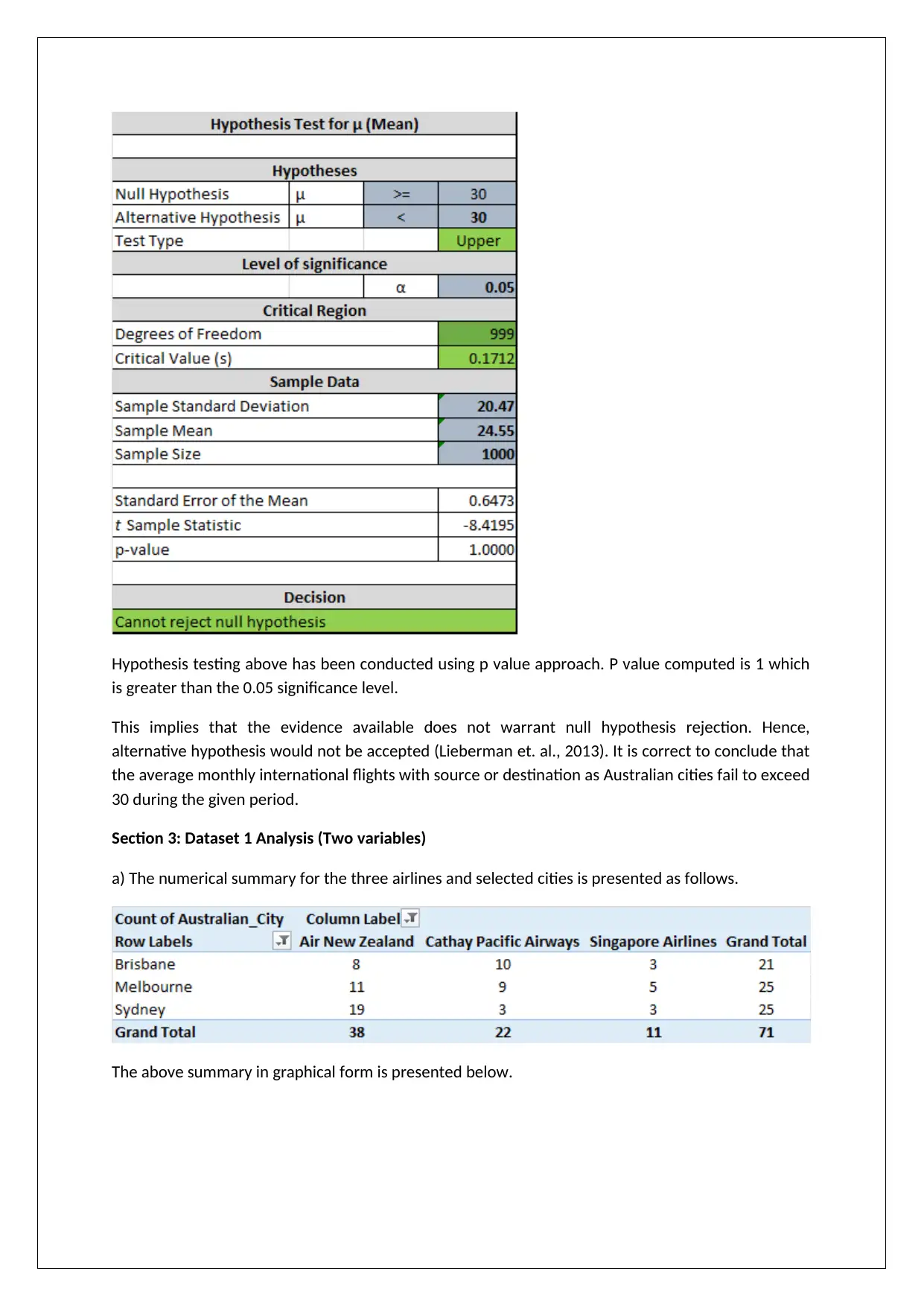
Hypothesis testing above has been conducted using p value approach. P value computed is 1 which
is greater than the 0.05 significance level.
This implies that the evidence available does not warrant null hypothesis rejection. Hence,
alternative hypothesis would not be accepted (Lieberman et. al., 2013). It is correct to conclude that
the average monthly international flights with source or destination as Australian cities fail to exceed
30 during the given period.
Section 3: Dataset 1 Analysis (Two variables)
a) The numerical summary for the three airlines and selected cities is presented as follows.
The above summary in graphical form is presented below.
is greater than the 0.05 significance level.
This implies that the evidence available does not warrant null hypothesis rejection. Hence,
alternative hypothesis would not be accepted (Lieberman et. al., 2013). It is correct to conclude that
the average monthly international flights with source or destination as Australian cities fail to exceed
30 during the given period.
Section 3: Dataset 1 Analysis (Two variables)
a) The numerical summary for the three airlines and selected cities is presented as follows.
The above summary in graphical form is presented below.
Paraphrase This Document
Need a fresh take? Get an instant paraphrase of this document with our AI Paraphraser
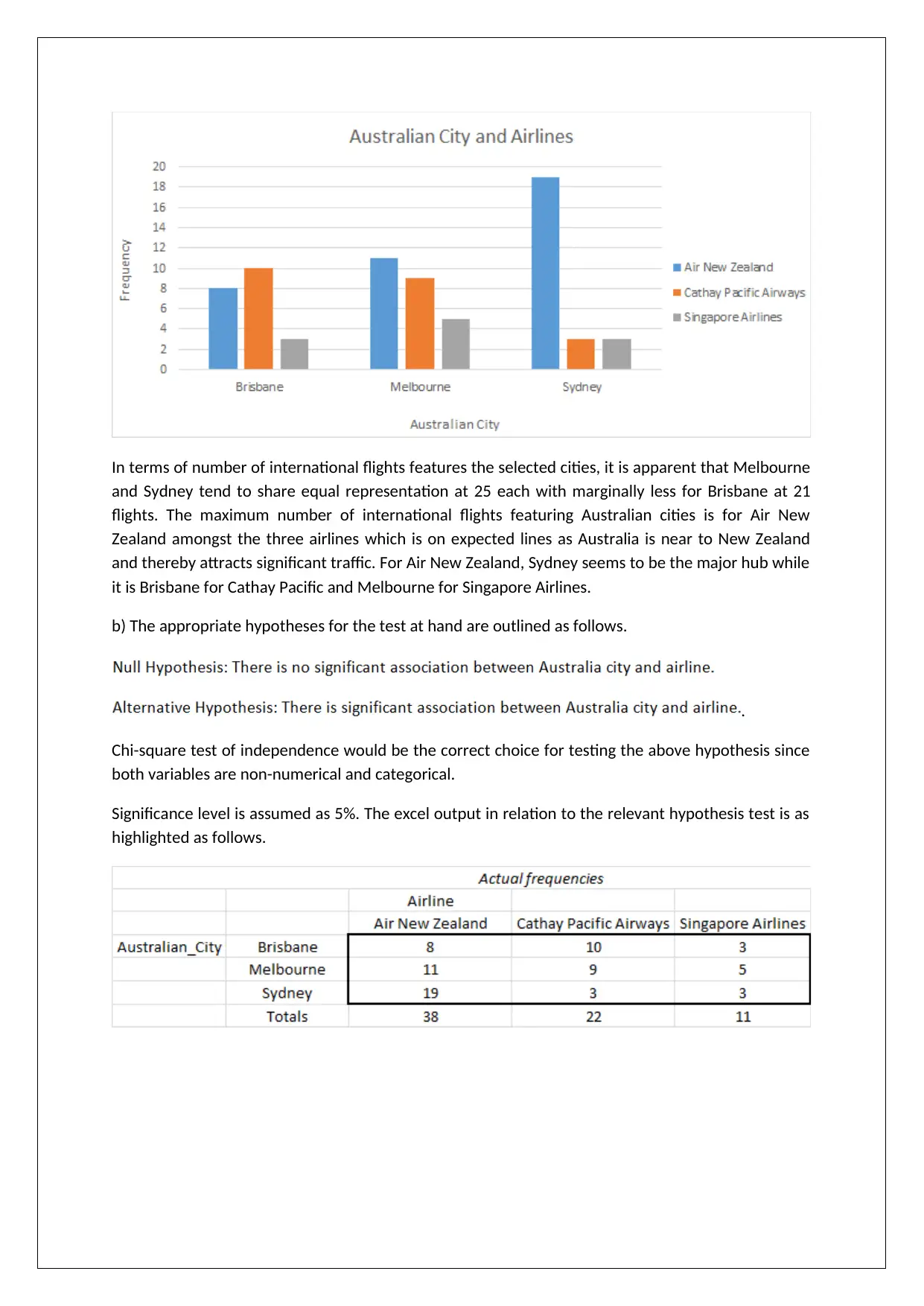
In terms of number of international flights features the selected cities, it is apparent that Melbourne
and Sydney tend to share equal representation at 25 each with marginally less for Brisbane at 21
flights. The maximum number of international flights featuring Australian cities is for Air New
Zealand amongst the three airlines which is on expected lines as Australia is near to New Zealand
and thereby attracts significant traffic. For Air New Zealand, Sydney seems to be the major hub while
it is Brisbane for Cathay Pacific and Melbourne for Singapore Airlines.
b) The appropriate hypotheses for the test at hand are outlined as follows.
.
Chi-square test of independence would be the correct choice for testing the above hypothesis since
both variables are non-numerical and categorical.
Significance level is assumed as 5%. The excel output in relation to the relevant hypothesis test is as
highlighted as follows.
and Sydney tend to share equal representation at 25 each with marginally less for Brisbane at 21
flights. The maximum number of international flights featuring Australian cities is for Air New
Zealand amongst the three airlines which is on expected lines as Australia is near to New Zealand
and thereby attracts significant traffic. For Air New Zealand, Sydney seems to be the major hub while
it is Brisbane for Cathay Pacific and Melbourne for Singapore Airlines.
b) The appropriate hypotheses for the test at hand are outlined as follows.
.
Chi-square test of independence would be the correct choice for testing the above hypothesis since
both variables are non-numerical and categorical.
Significance level is assumed as 5%. The excel output in relation to the relevant hypothesis test is as
highlighted as follows.
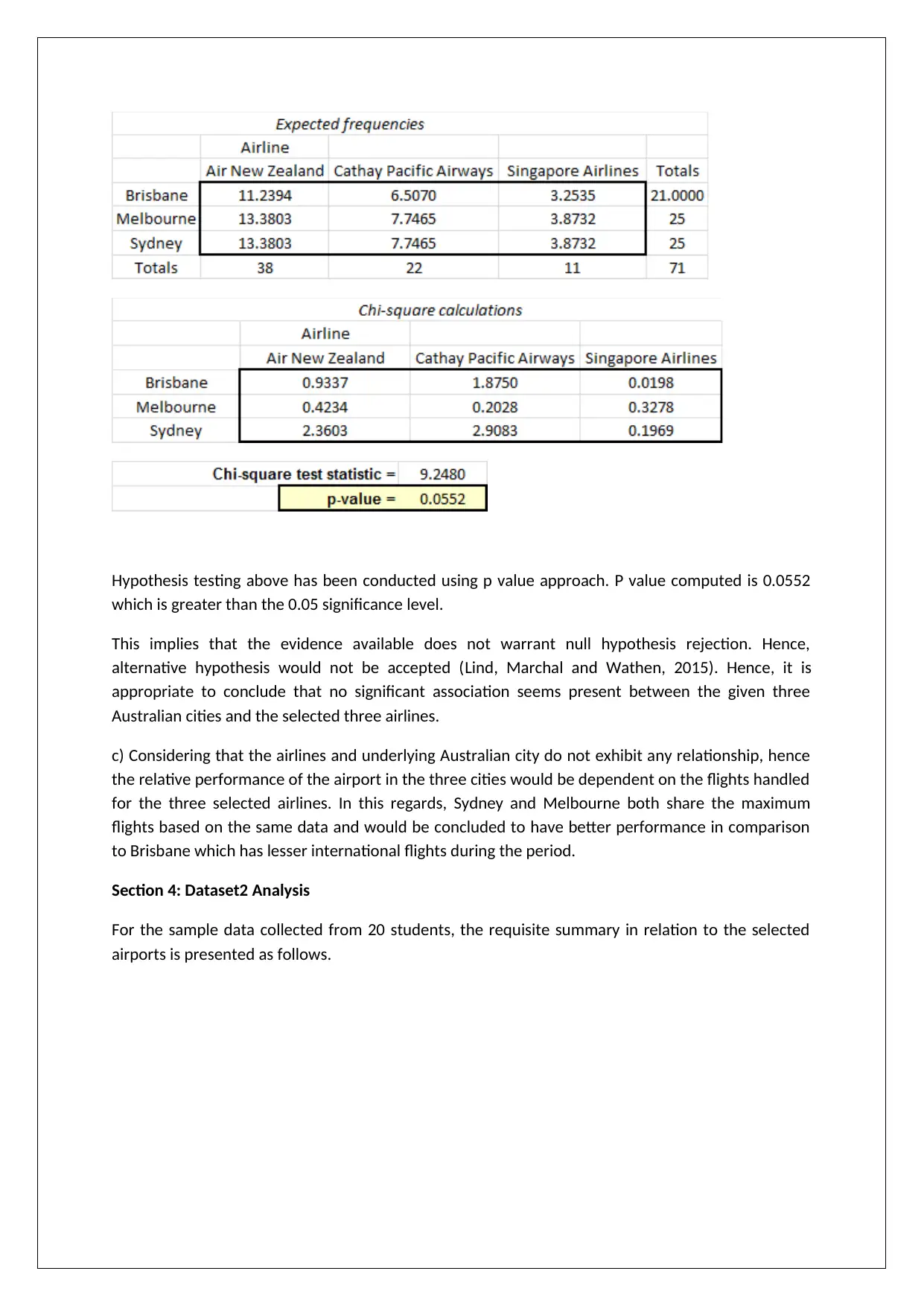
Hypothesis testing above has been conducted using p value approach. P value computed is 0.0552
which is greater than the 0.05 significance level.
This implies that the evidence available does not warrant null hypothesis rejection. Hence,
alternative hypothesis would not be accepted (Lind, Marchal and Wathen, 2015). Hence, it is
appropriate to conclude that no significant association seems present between the given three
Australian cities and the selected three airlines.
c) Considering that the airlines and underlying Australian city do not exhibit any relationship, hence
the relative performance of the airport in the three cities would be dependent on the flights handled
for the three selected airlines. In this regards, Sydney and Melbourne both share the maximum
flights based on the same data and would be concluded to have better performance in comparison
to Brisbane which has lesser international flights during the period.
Section 4: Dataset2 Analysis
For the sample data collected from 20 students, the requisite summary in relation to the selected
airports is presented as follows.
which is greater than the 0.05 significance level.
This implies that the evidence available does not warrant null hypothesis rejection. Hence,
alternative hypothesis would not be accepted (Lind, Marchal and Wathen, 2015). Hence, it is
appropriate to conclude that no significant association seems present between the given three
Australian cities and the selected three airlines.
c) Considering that the airlines and underlying Australian city do not exhibit any relationship, hence
the relative performance of the airport in the three cities would be dependent on the flights handled
for the three selected airlines. In this regards, Sydney and Melbourne both share the maximum
flights based on the same data and would be concluded to have better performance in comparison
to Brisbane which has lesser international flights during the period.
Section 4: Dataset2 Analysis
For the sample data collected from 20 students, the requisite summary in relation to the selected
airports is presented as follows.
⊘ This is a preview!⊘
Do you want full access?
Subscribe today to unlock all pages.

Trusted by 1+ million students worldwide
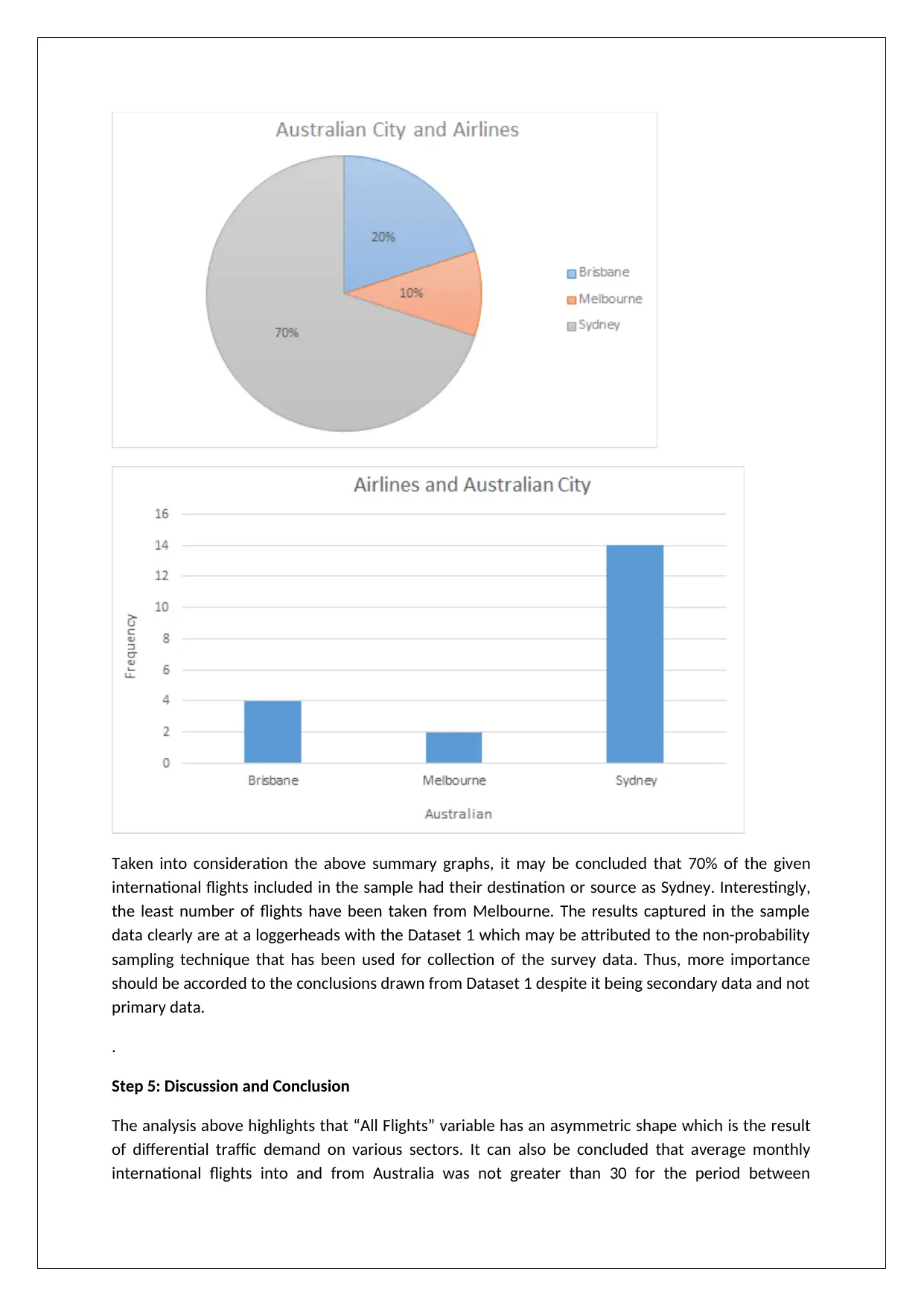
Taken into consideration the above summary graphs, it may be concluded that 70% of the given
international flights included in the sample had their destination or source as Sydney. Interestingly,
the least number of flights have been taken from Melbourne. The results captured in the sample
data clearly are at a loggerheads with the Dataset 1 which may be attributed to the non-probability
sampling technique that has been used for collection of the survey data. Thus, more importance
should be accorded to the conclusions drawn from Dataset 1 despite it being secondary data and not
primary data.
.
Step 5: Discussion and Conclusion
The analysis above highlights that “All Flights” variable has an asymmetric shape which is the result
of differential traffic demand on various sectors. It can also be concluded that average monthly
international flights into and from Australia was not greater than 30 for the period between
international flights included in the sample had their destination or source as Sydney. Interestingly,
the least number of flights have been taken from Melbourne. The results captured in the sample
data clearly are at a loggerheads with the Dataset 1 which may be attributed to the non-probability
sampling technique that has been used for collection of the survey data. Thus, more importance
should be accorded to the conclusions drawn from Dataset 1 despite it being secondary data and not
primary data.
.
Step 5: Discussion and Conclusion
The analysis above highlights that “All Flights” variable has an asymmetric shape which is the result
of differential traffic demand on various sectors. It can also be concluded that average monthly
international flights into and from Australia was not greater than 30 for the period between
Paraphrase This Document
Need a fresh take? Get an instant paraphrase of this document with our AI Paraphraser
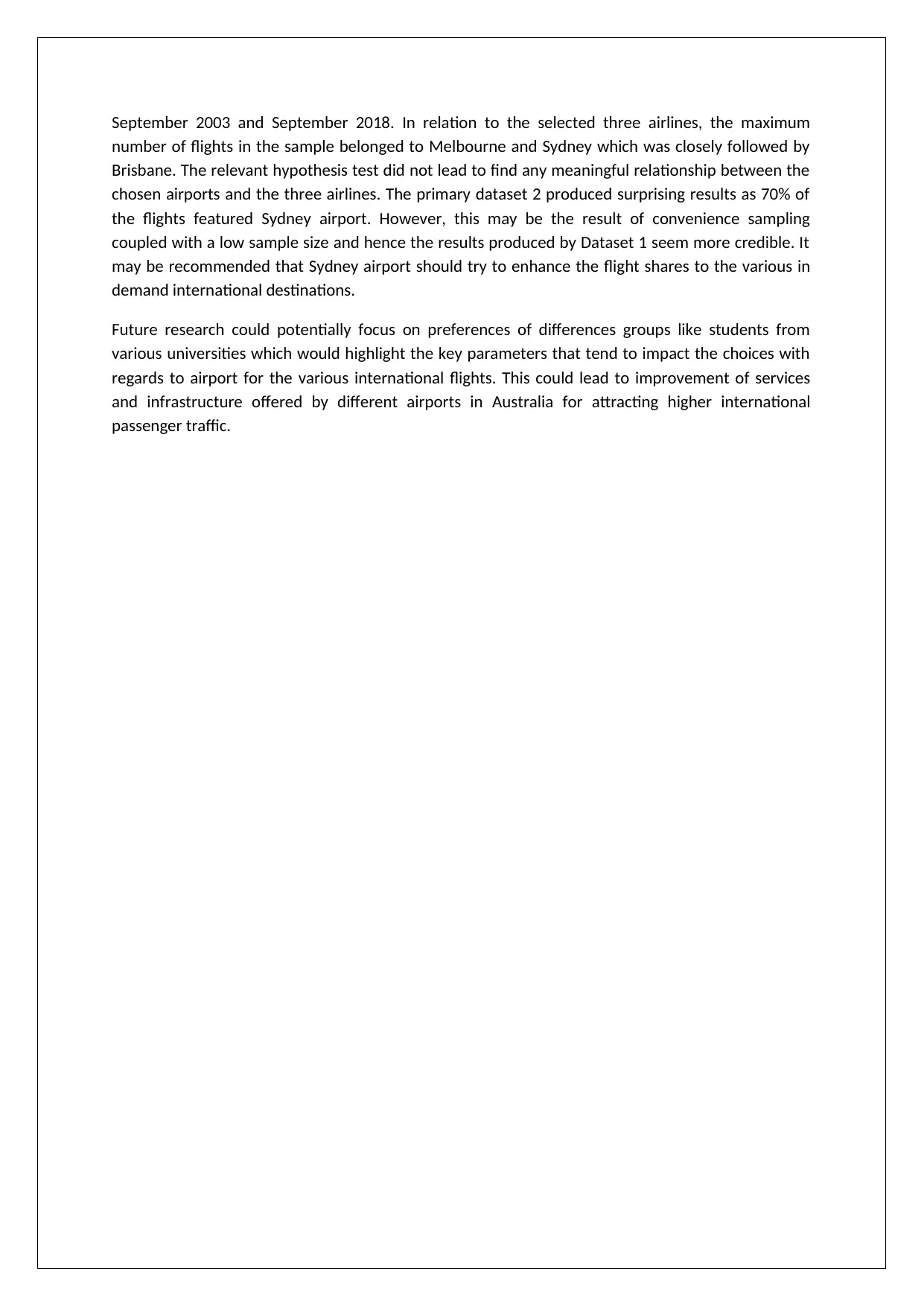
September 2003 and September 2018. In relation to the selected three airlines, the maximum
number of flights in the sample belonged to Melbourne and Sydney which was closely followed by
Brisbane. The relevant hypothesis test did not lead to find any meaningful relationship between the
chosen airports and the three airlines. The primary dataset 2 produced surprising results as 70% of
the flights featured Sydney airport. However, this may be the result of convenience sampling
coupled with a low sample size and hence the results produced by Dataset 1 seem more credible. It
may be recommended that Sydney airport should try to enhance the flight shares to the various in
demand international destinations.
Future research could potentially focus on preferences of differences groups like students from
various universities which would highlight the key parameters that tend to impact the choices with
regards to airport for the various international flights. This could lead to improvement of services
and infrastructure offered by different airports in Australia for attracting higher international
passenger traffic.
number of flights in the sample belonged to Melbourne and Sydney which was closely followed by
Brisbane. The relevant hypothesis test did not lead to find any meaningful relationship between the
chosen airports and the three airlines. The primary dataset 2 produced surprising results as 70% of
the flights featured Sydney airport. However, this may be the result of convenience sampling
coupled with a low sample size and hence the results produced by Dataset 1 seem more credible. It
may be recommended that Sydney airport should try to enhance the flight shares to the various in
demand international destinations.
Future research could potentially focus on preferences of differences groups like students from
various universities which would highlight the key parameters that tend to impact the choices with
regards to airport for the various international flights. This could lead to improvement of services
and infrastructure offered by different airports in Australia for attracting higher international
passenger traffic.
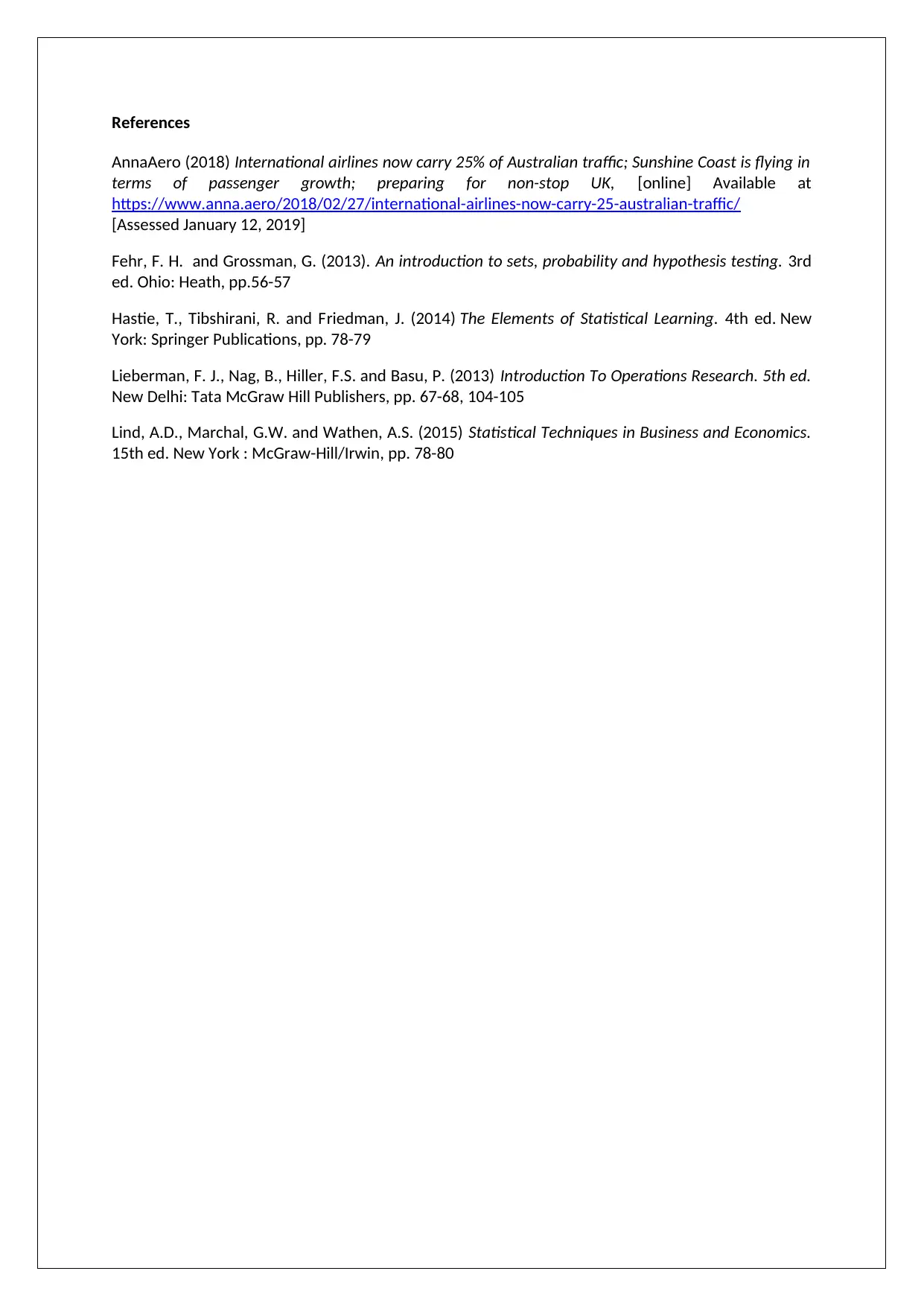
References
AnnaAero (2018) International airlines now carry 25% of Australian traffic; Sunshine Coast is flying in
terms of passenger growth; preparing for non-stop UK, [online] Available at
https://www.anna.aero/2018/02/27/international-airlines-now-carry-25-australian-traffic/
[Assessed January 12, 2019]
Fehr, F. H. and Grossman, G. (2013). An introduction to sets, probability and hypothesis testing. 3rd
ed. Ohio: Heath, pp.56-57
Hastie, T., Tibshirani, R. and Friedman, J. (2014) The Elements of Statistical Learning. 4th ed. New
York: Springer Publications, pp. 78-79
Lieberman, F. J., Nag, B., Hiller, F.S. and Basu, P. (2013) Introduction To Operations Research. 5th ed.
New Delhi: Tata McGraw Hill Publishers, pp. 67-68, 104-105
Lind, A.D., Marchal, G.W. and Wathen, A.S. (2015) Statistical Techniques in Business and Economics.
15th ed. New York : McGraw-Hill/Irwin, pp. 78-80
AnnaAero (2018) International airlines now carry 25% of Australian traffic; Sunshine Coast is flying in
terms of passenger growth; preparing for non-stop UK, [online] Available at
https://www.anna.aero/2018/02/27/international-airlines-now-carry-25-australian-traffic/
[Assessed January 12, 2019]
Fehr, F. H. and Grossman, G. (2013). An introduction to sets, probability and hypothesis testing. 3rd
ed. Ohio: Heath, pp.56-57
Hastie, T., Tibshirani, R. and Friedman, J. (2014) The Elements of Statistical Learning. 4th ed. New
York: Springer Publications, pp. 78-79
Lieberman, F. J., Nag, B., Hiller, F.S. and Basu, P. (2013) Introduction To Operations Research. 5th ed.
New Delhi: Tata McGraw Hill Publishers, pp. 67-68, 104-105
Lind, A.D., Marchal, G.W. and Wathen, A.S. (2015) Statistical Techniques in Business and Economics.
15th ed. New York : McGraw-Hill/Irwin, pp. 78-80
⊘ This is a preview!⊘
Do you want full access?
Subscribe today to unlock all pages.

Trusted by 1+ million students worldwide
1 out of 9
Related Documents
Your All-in-One AI-Powered Toolkit for Academic Success.
+13062052269
info@desklib.com
Available 24*7 on WhatsApp / Email
![[object Object]](/_next/static/media/star-bottom.7253800d.svg)
Unlock your academic potential
Copyright © 2020–2025 A2Z Services. All Rights Reserved. Developed and managed by ZUCOL.





